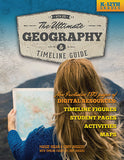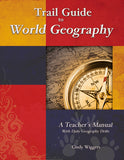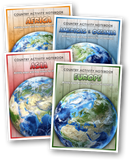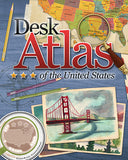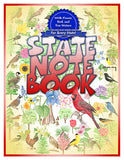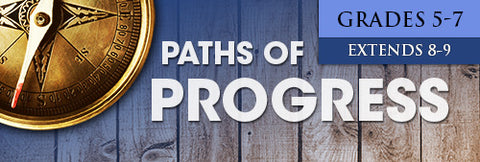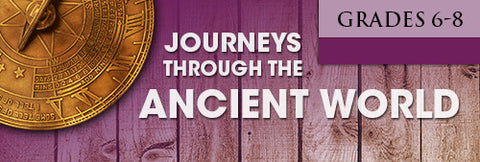Homeschool Curriculum: Trail Guide to Learning

The Trail Guide to Learning series is a complete homeschool curriculum that teaches every subject except for math, using an integrated approach to develop thinking skills.
Try it out FREE today: click here
The Trail Guide to Learning series weaves together aspects from Charlotte Mason’s methods of natural education, and incorporates the ideas of Dr. Benjamin Bloom’s research on thinking skills, while fully utilizing the time-tested approach developed by noted author and educator, Dr. Ruth Beechick. Dr. Beechick’s educational philosophy is that developing thinking skills is paramount, learning different subjects (science, history, geography, etc.) is done best in a unified and focused manner, stories are great teaching tools, and that language skills need to be learned in the context of content, not as isolated subjects.
We not only cover each subject, but every subject in the Trail Guide relates. It is a natural way of learning as topics flow from one to the other. Children learn best when subjects overlap and build upon a main concept.
For example, in Paths of Exploration, students learn how our country was discovered and explored, from Columbus to the Westward Expansion. While studying the life and explorations of Christopher Columbus, students learn about his travels, read about his life in their literature, map out his treks in their geography, learn how he used the stars for navigation in their science lessons, and tie in activities like making a model ship out of a milk carton. When your child is able to make all these connections, he will have better retention and a deeper understanding of the subject matter.
The more sensory involvement you have with one topic, the more likely you are to remember and use that information. As children learn, they will share their experiences through notebooking, presentations and hands-on activities. Art, cooking, music, and games combine to give children a taste of the times and a personal connection with the content that is unmatched by reading alone.
The Steps for Thinking portion of the Trail Guide serves as a backbone to every lesson and helps tie in the overall theme of each unit. Steps for Thinking addresses main concepts and character qualities from week to week and encourages deeper thinking about those concepts. This section also provides a general framework of thought process and promotes an active approach to learning. It is recommended that you read and discuss each step together at the beginning of your lessons and look for opportunities throughout the week to relate back to those discussions. In doing so, your children will learn to be aware of the bigger picture.
What is Dr. Ruth Beechick's philosophy?
Developing thinking skills are paramount; that learning different subjects (science, history, geography, etc.) is done best in a unified and focused manner; that stories are great teaching tools; and that language skills need to be learned in the context of content, not as isolated subjects. The first three levels of the Trail Guide to Learning Series focus on American History. Building a preliminary sense of identity with our past as a nation is important and enjoyable to students of this age group, as well as in keeping with their developing thinking skills.
Can you adapt this program for older students? If so, how?
You can use the Enrichment activities included in the sourcebook to make it appropriate for a seventh grader. In addition to that, take them to the library and get whatever books you can find, or use the internet to find as much as they can on the unit topic (Revolutionary War, Civil War, etc.) and as they read their resources, have them compare (tell what is the same as our resources) and contrast (tell what is different from our resources). This is a good critical thinking idea. Another quicker and easier way to do this is to find videos on each topic that you think are appropriate and then compare/contrast them with what our resources have to say about these folks. Encourage your older students to share the information they find out with you. This is a good thinking/presenting skill, as well as a way to develop summarizing ability.
A Middle School Supplement is also available to provide guidance for older students. Content follows along with the sourcebook but at a higher, more challenging level. It includes higher level literature books, writing assignments, activities, and thinking skill points. Connect all your students to the same time period and type of learning with the Trail Guide to Learning series Middle School Supplement. (Available in digital format.)
How many levels are used to teach American history?
We teach American History using a three-year program. Here is a summary of the three Paths.
Paths of Exploration — (Grades 3-5) The character and experiences of explorers who shaped us as a nation with their vision, determination, bravery and sacrifice. They blazed a trail for others to follow. The focus here is on the type of thinking, leadership and skills that were needed to open up the way for others to follow. Primary science focus involves acquiring the basic skills of observation and recording (both drawing and writing), beginning life science through studying the animals and plant life of explored areas, including habitats and the relationship of these factors to the explorers. Some key figures studied: Columbus, the Jamestown settlers, the Pilgrims, Daniel Boone and Lewis and Clark.
Paths of Settlement — (Grades 4- 6) The settling of our nation is examined through the lives of leaders who made a difference by standing for their beliefs and making a way for us as a nation to follow and grow. Key events studied - the Colonial Period, the Revolutionary War, the War of 1812, the Civil War and Westward Expansion. What does it take to build a nation? Blazing a trail was the first step, building a foundation for growth and government is next. Primary science focus - Earth Science (geology, weather, land forms, climate) and the impact of these factors on settlement. Basic economics and international relationships are also addressed. Some key figures studied include George Washington, Paul Revere, Abigail Adams, Francis Scott Key, Clara Barton, Robert E. Lee, and Abraham Lincoln.
Paths of Progress — (Grades 5-7) To grow as a country, another group of leaders had to step forward during our history - scientists and inventors. They used their talents and abilities to answer questions that provided better ways of living and working. The lives of these devoted individuals and their contributions will be examined throughout our history, into the Industrial Revolution and the beginning of the 20th century. Primary science focus — physical science (such as energy, motion, atoms and molecules) and the geographic and economic impact of each development. Some key figures studied: Ben Franklin, Samuel Morse, George Washington Carver, the Wright Brothers, and Thomas Edison.
Why do you start with American history?
Children learn best by starting with the familiar. Studying American history first lays the firm foundation of your family's beliefs and shows what a good leader, government, and citizen look like. It also gives your children needed time to build thinking skills. When students are older they are better able to understand the events of world history, and more importantly, the causes and results of those events. With greater maturity in place, students are then ready to compare ancient times and events to our history and lives, learning the powerful lessons that can come from such a study.
Is your scope and sequence based from typical state standards? What was the criteria for the inclusion or exclusion of material?
Yes, the criteria by which content and concepts were chosen is the typical course of study for the grades included. They were also chosen by the author's experience as an educator (for 30 years) and our experience as homeschooling parents with now grown homeschooling graduates. Since our base is the philosophy of Dr. Beechick, this also influenced our choices as to what was taught and the order in which skills were introduced.
Is there testing over the material? How and why?
With the tutorial, interactive approach used in TGLS, and the Student Notebook work, the parent has ample opportunity to "keep her finger on the pulse" of what is being learned and retained. This fact would/should render formal testing somewhat redundant. However, in reality it's often reassuring to have an assessment that can be scored and added to a child's portfolio to "document" that such and such was covered and learned.
These assessments are available separately since they are not used by everyone. The assessments are formatted for each of the levels in the book, and are designed to be administered at the end of each unit. Also, additional copies of various Student Notebook pages can be made, if desired, to recheck comprehension.
Just FYI, the last week of each unit contains a good bit of review, and each week of the last unit focuses on review of one of the previous five. For instance, Lesson 1 of Sea to Shining Sea (Unit 6) in Settlement contains a review of Growing Pains (Unit 1).
Is there mention of other world events going on during the study of each unit?
World events are incorporated only on the occasion when something is mentioned in the real books that would warrant further examination.
Will this curriculum continue beyond 8th grade?
Yes. We will be adding to the series. After the three years of American History in the Paths, there are three levels of World History in Journeys through the Ancient World for grades 6, 7, and 8. These levels are also multi-age for the convenience of homeschool families.
A second year of Journeys is expected to be available in the future. In addition, plans are in the works for High School which will center around Modern American History, Modern World History, and Government and Economics.
Are the readers, the notebooks, and this curriculum written with Christian values throughout?
Our books and resources are definitely Christian-friendly.
Is the Light for the Trail specific to one denomination? Did you write it? How is it incorporated?
We wrote Light for the Trail in such a way as to be friendly to all denominations. Actual instruction on application of scripture remains firmly in the hands of the parent.
Light for the Trail integrates into the program as an extension of Beechick principles. Although it incorporates verses that focus attention on a specific character trait for each unit such as “perseverance” or “faith”—and students are asked to draw relationships to what they are studying—its primary focus is committing scripture to memory, and using it to change heart attitudes (both very dear to Dr. Beechick's heart). It is based on four days of examination and memorization of a verse, with the fifth day (or part) set aside for review and possibly completion of activities. It is not a commentary or a "fill in the blank," but rather a guide for meaningful discussion and an opportunity for children to write down their personal thoughts and insights. Parents are given occasions to share their own experiences that relate to the study—to tell their stories—because those are the things that bring spiritual truths to life. In addition to the weekly memory verse, there are two longer memory projects per unit.
Can living books of the parents choice be incorporated without overloading the child?
Absolutely. If the books are recreational they can be incorporated into Independent Reading time (if the child is interested and they're consistent with his reading level) or used as bedtime (or other time) read-aloud. If they're academic they can be incorporated into research (students are often directed to find out more about topics at the library or on the Internet.) Every family has its own style and preferences, and TGLS recognizes and tries to accommodate that fact.
If you have further questions about the Trail Guide curriculae, we encourage you to download our 16-page curriculum overview booklet. It contains more in-depth descriptions of each level, reviews and recommendations, and answers to the most commonly-asked questions.
Paths of Exploration is the first step on the Trail Guide to Learning. Follow famous explorers and pioneers across America and let geography be your guide to science, history, language skills, and the arts. This journey will teach students HOW to think by asking, answering, and investigating questions about our great country’s beginning and growth. The paths of the explorers are seen through multi-disciplinary eyes, but always with the same goals: to make learning enjoyable, memorable, and motivating. This full, one-year course is targeted for grades 3-5 (adaptable for 2nd and 6th).
Paths of Settlement is the second step on the Trail Guide to Learning. Key events studied include the Colonial Period, the Revolutionary War, the War of 1812, the Civil War, and Westward Expansion. Learn about the accomplishments of great Americans like George Washington and Patrick Henry who built upon the trail blazed by brave explorers. Their actions teach us the principles of freedom and citizenship—founding and expanding our country, strengthening us in times of war and binding us together in times of struggle. This full, one-year course is targeted for grades 4-6, but the lessons can easily be adapted for 3rd and 7th grades.
Paths of Progress is the third step on the Trail Guide to Learning. To grow as a country, another group of leaders had to step forward during our history—scientists and inventors. Study those who used their talents and abilities to answer questions that provided better ways of living and working. The lives of these devoted individuals and their contributions will be examined throughout our history, into the Industrial Revolution and the beginning of the 20th century. Primary science focus involves physical science (such as energy, motion, and work) and the economic impact of each development. Key figures studied include Ben Franklin, Samuel Morse, George Washington Carver, the Wright Brothers, and Thomas Edison. This full, one-year course is targeted for grades 5-7, but the lessons can easily be adapted for 4th and 8th grades.
Journeys Through the Ancient World is the fourth step on the Trail Guide to Learning. This level of the curriculum will transport your students into four important early civilizations—Egypt, Israel, Greece, and Rome. Astronomy, world view comparisons, typing, Hebrew, geography, and language skills are included in each of four, nine-week units. The Bible is an essential part of this study, as both an historical and a literary text. This full, one-year course is targeted for grades 6-8.

